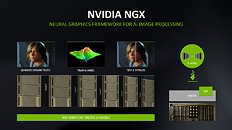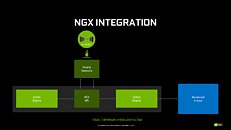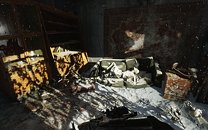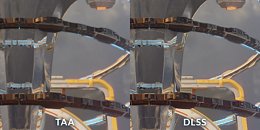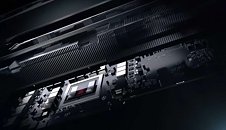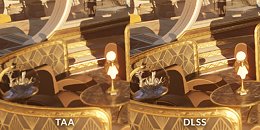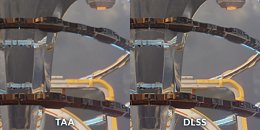Apr 18th, 2025 15:33 EDT
change timezone
Latest GPU Drivers
New Forum Posts
- Can Intel recover in DYI market anytime soon? (9)
- Place your bets, what node will rtx 6000/RDNA 5(UDNA 1?) use (7)
- GPU Pricing and Performance (15)
- What are you playing? (23396)
- TPU's Nostalgic Hardware Club (20256)
- Spoofer Modified SMBIOS/BIOS – Need Help Restoring Original Motherboard Info (TUF GAMING B550-PLUS WiFi II) (2)
- Tried installing 576.02 - installer window disappears (20)
- RX 9000 series GPU Owners Club (392)
- GPU Database (300)
- Drives fail to work with Rufus Windows TO GO (2)
Popular Reviews
- ASUS GeForce RTX 5060 Ti TUF OC 16 GB Review
- NVIDIA GeForce RTX 5060 Ti PCI-Express x8 Scaling
- Palit GeForce RTX 5060 Ti Infinity 3 16 GB Review
- G.SKILL Trident Z5 NEO RGB DDR5-6000 32 GB CL26 Review - AMD EXPO
- ASUS GeForce RTX 5060 Ti Prime OC 16 GB Review
- Teevolution Terra Pro Review
- MSI GeForce RTX 5060 Ti Gaming OC 16 GB Review
- Zotac GeForce RTX 5060 Ti AMP 16 GB Review
- MSI GeForce RTX 5060 Ti Gaming Trio OC 16 GB Review
- ASUS GeForce RTX 5080 TUF OC Review
Controversial News Posts
- NVIDIA GeForce RTX 5060 Ti 16 GB SKU Likely Launching at $499, According to Supply Chain Leak (182)
- NVIDIA Sends MSRP Numbers to Partners: GeForce RTX 5060 Ti 8 GB at $379, RTX 5060 Ti 16 GB at $429 (127)
- Nintendo Confirms That Switch 2 Joy-Cons Will Not Utilize Hall Effect Stick Technology (105)
- Over 200,000 Sold Radeon RX 9070 and RX 9070 XT GPUs? AMD Says No Number was Given (100)
- Nintendo Switch 2 Launches June 5 at $449.99 with New Hardware and Games (99)
- NVIDIA Launches GeForce RTX 5060 Series, Beginning with RTX 5060 Ti This Week (98)
- Sony Increases the PS5 Pricing in EMEA and ANZ by Around 25 Percent (85)
- NVIDIA PhysX and Flow Made Fully Open-Source (77)
News Posts matching #SMAA
Return to Keyword Browsing
NVIDIA: Image Quality for DLSS in Metro Exodus to Be Improved in Further Updates, and the Nature of the Beast
NVIDIA, in a blog post/Q&A on its DLSS technology, promised implementation and image quality improvements on its Metro Exodus rendition of the technology. If you'll remember, AMD recently vouched for other, non-proprietary ways of achieving desired quality of AA technology across resolutions such as TAA and SMAA, saying that DLSS introduces "(...) image artefacts caused by the upscaling and harsh sharpening." NVIDIA in its blog post has dissected DLSS in its implementation, also clarifying some lingering questions on the technology and its resolution limitations that some us here at TPU had already wondered about.
The blog post describes some of the limitations in DLSS technology, and why exactly image quality issues might be popping out here and there in titles. As we knew from NVIDIA's initial RTX press briefing, DLSS basically works on top of an NVIDIA neural network. Titled the NGX, it processes millions of frames from a single game at varying resolutions, with DLSS, and compares it to a given "ground truth image" - the highest quality possible output sans any shenanigans, generated from just pure raw processing power. The objective is to train the network towards generating this image without the performance cost. This DLSS model is then made available for NVIDIA's client to download and to be run at your local RTX graphics card level, which is why DLSS image quality can be improved with time. And it also helps explain why closed implementations of the technology, such as 3D Mark's Port Royal benchmark, show such incredible image quality scenarios compared to, say, Metro Exodus - there is a very, very limited number of frames that the neural network needs to process towards achieving the best image quality.Forumites: This is an Editorial
The blog post describes some of the limitations in DLSS technology, and why exactly image quality issues might be popping out here and there in titles. As we knew from NVIDIA's initial RTX press briefing, DLSS basically works on top of an NVIDIA neural network. Titled the NGX, it processes millions of frames from a single game at varying resolutions, with DLSS, and compares it to a given "ground truth image" - the highest quality possible output sans any shenanigans, generated from just pure raw processing power. The objective is to train the network towards generating this image without the performance cost. This DLSS model is then made available for NVIDIA's client to download and to be run at your local RTX graphics card level, which is why DLSS image quality can be improved with time. And it also helps explain why closed implementations of the technology, such as 3D Mark's Port Royal benchmark, show such incredible image quality scenarios compared to, say, Metro Exodus - there is a very, very limited number of frames that the neural network needs to process towards achieving the best image quality.Forumites: This is an Editorial

AMD Doesn't Believe in NVIDIA's DLSS, Stands for Open SMAA and TAA Solutions
A report via PCGamesN places AMD's stance on NVIDIA's DLSS as a rather decided one: the company stands for further development of SMAA (Enhanced Subpixel Morphological Antialiasing) and TAA (Temporal Antialising) solutions on current, open frameworks, which, according to AMD's director of marketing, Sasa Marinkovic, "(...) are going to be widely implemented in today's games, and that run exceptionally well on Radeon VII", instead of investing in yet another proprietary solution. While AMD pointed out that DLSS' market penetration was a low one, that's not the main issue of contention. In fact, AMD decides to go head-on against NVIDIA's own technical presentations, comparing DLSS' image quality and performance benefits against a native-resolution, TAA-enhanced image - they say that SMAA and TAA can work equally as well without "the image artefacts caused by the upscaling and harsh sharpening of DLSS."
Of course, AMD may only be speaking from the point of view of a competitor that has no competing solution. However, company representatives said that they could, in theory, develop something along the lines of DLSS via a GPGPU framework - a task for which AMD's architectures are usually extremely well-suited. But AMD seems to take the eyes of its DLSS-defusing moves, however, as AMD's Nish Neelalojanan, a Gaming division exec, talks about potential DLSS-like implementations across "Some of the other broader available frameworks, like WindowsML and DirectML", and that these are "something we [AMD] are actively looking at optimizing… At some of the previous shows we've shown some of the upscaling, some of the filters available with WindowsML, running really well with some of our Radeon cards." So whether it's an actual image-quality philosophy, or just a competing technology's TTM (time to market) one, only AMD knows.
Of course, AMD may only be speaking from the point of view of a competitor that has no competing solution. However, company representatives said that they could, in theory, develop something along the lines of DLSS via a GPGPU framework - a task for which AMD's architectures are usually extremely well-suited. But AMD seems to take the eyes of its DLSS-defusing moves, however, as AMD's Nish Neelalojanan, a Gaming division exec, talks about potential DLSS-like implementations across "Some of the other broader available frameworks, like WindowsML and DirectML", and that these are "something we [AMD] are actively looking at optimizing… At some of the previous shows we've shown some of the upscaling, some of the filters available with WindowsML, running really well with some of our Radeon cards." So whether it's an actual image-quality philosophy, or just a competing technology's TTM (time to market) one, only AMD knows.
Apr 18th, 2025 15:33 EDT
change timezone
Latest GPU Drivers
New Forum Posts
- Can Intel recover in DYI market anytime soon? (9)
- Place your bets, what node will rtx 6000/RDNA 5(UDNA 1?) use (7)
- GPU Pricing and Performance (15)
- What are you playing? (23396)
- TPU's Nostalgic Hardware Club (20256)
- Spoofer Modified SMBIOS/BIOS – Need Help Restoring Original Motherboard Info (TUF GAMING B550-PLUS WiFi II) (2)
- Tried installing 576.02 - installer window disappears (20)
- RX 9000 series GPU Owners Club (392)
- GPU Database (300)
- Drives fail to work with Rufus Windows TO GO (2)
Popular Reviews
- ASUS GeForce RTX 5060 Ti TUF OC 16 GB Review
- NVIDIA GeForce RTX 5060 Ti PCI-Express x8 Scaling
- Palit GeForce RTX 5060 Ti Infinity 3 16 GB Review
- G.SKILL Trident Z5 NEO RGB DDR5-6000 32 GB CL26 Review - AMD EXPO
- ASUS GeForce RTX 5060 Ti Prime OC 16 GB Review
- Teevolution Terra Pro Review
- MSI GeForce RTX 5060 Ti Gaming OC 16 GB Review
- Zotac GeForce RTX 5060 Ti AMP 16 GB Review
- MSI GeForce RTX 5060 Ti Gaming Trio OC 16 GB Review
- ASUS GeForce RTX 5080 TUF OC Review
Controversial News Posts
- NVIDIA GeForce RTX 5060 Ti 16 GB SKU Likely Launching at $499, According to Supply Chain Leak (182)
- NVIDIA Sends MSRP Numbers to Partners: GeForce RTX 5060 Ti 8 GB at $379, RTX 5060 Ti 16 GB at $429 (127)
- Nintendo Confirms That Switch 2 Joy-Cons Will Not Utilize Hall Effect Stick Technology (105)
- Over 200,000 Sold Radeon RX 9070 and RX 9070 XT GPUs? AMD Says No Number was Given (100)
- Nintendo Switch 2 Launches June 5 at $449.99 with New Hardware and Games (99)
- NVIDIA Launches GeForce RTX 5060 Series, Beginning with RTX 5060 Ti This Week (98)
- Sony Increases the PS5 Pricing in EMEA and ANZ by Around 25 Percent (85)
- NVIDIA PhysX and Flow Made Fully Open-Source (77)
